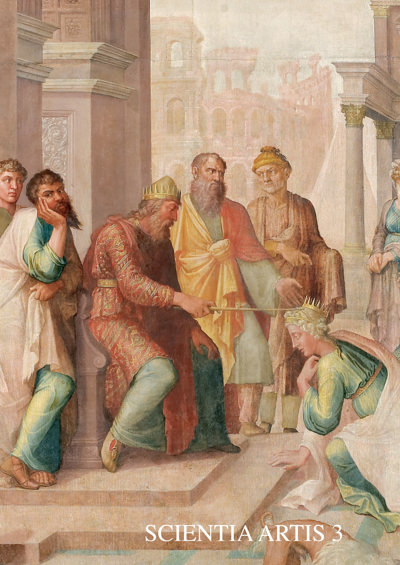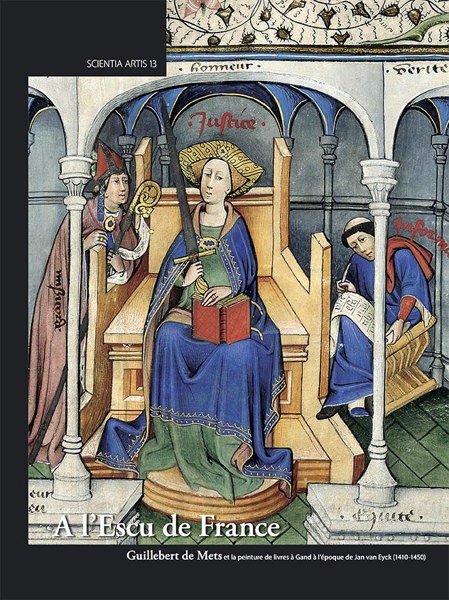
Flesh, Gold and Wood. The Saint-Denis altarpiece in Liège and the question of partial paint practices in the 16th Century
Proceedings of the Conference Held at the Royal Institute for Cultural Heritage in Brussels, 22-24 October 2015
Emmanuelle Mercier, Ria De Boodt, Pierre-Yves Kairis (eds)
- Pages: 484 p.
- Size:230 x 290 mm
- Language(s):English, French
- Publication Year:2021
- € 56,61 EXCL. VAT RETAIL PRICE
- ISBN: 978-2-930054-40-7
- Hardback
- Available
"This new publication, which has an unusual cohesiveness and structure compared to most conference proceedings, demonstrates the power of scientific studies, working in concert with art historical research, for making critical advances in understanding major works of art. While not solving every question, the scientific analysis furnished stunning new discoveries, above all, confirmation, for the first time, of the practice of partial polychromy within the Netherlandish carved altarpiece tradition. In addition, the technical analysis also confirms that the predella was produced at the same time as the case, supporting the theory that the work was fully commissioned and accommodated to sixteenth-century tastes for artworks mixing Gothic and Italianate styles." (Lynn F. Jacobs, in Historians of Netherlandish Art Reviews, May 2020).
« Ce volume d’actes nous démontre, s’il fallait encore le faire, que les chantiers de restauration pluridisciplinaires se révèlent être de formidables catalyseurs pour la recherche scientifique. » (Sophie Balace, dans Revue belge de philologie et d'histoire, 99(3/4), 2021, p. 1030)
The impressive altarpiece in the church of Saint-Denis in Liège is one of the most prestigious but also one of the most enigmatic witnesses to the rich Brabantine altarpiece production at the end of the Middle Ages. The interdisciplinary study carried out during its restoration at the Royal Institute for Cultural Heritage (KIK-IRPA) in Brussels between 2012 and 2014 allowed to resolve some of the questions involved and to propose new refreshing hypotheses. The attribution to the Borman, the most prestigious Brussels sculptor family, was refined, as was its dating in the early 1530s, when the vocabulary of Italian Renaissance began to invade the art of the Meuse banks simultaneously with the still well-anchored Gothic style.
This volume provides a broad platform for the exceptional character of the partial polychromy of the altarpiece, highlighted by the investigation conducted at the KIK-IRPA. This research was nourished by many comparative reflections. The abundant and varied studies presented here, mainly originate from an international conference held in October 2015. In addition, the restoration at KIK-IRPA, between 2016 and 2019, of some of the painted panels that initially adorned the shutters of the altarpiece, also allowed a beneficial reconsideration of the participation of the great Liège painter Lambert Lombard and some local workshop. Starting from an amazing work, they represent an important part of the artistic activity in Liège revived by Prince-Bishop Érard de La Marck.
Preface
Manfred Koller
Introduction
Emmanuelle Mercier, Ria De Boodt and Pierre-Yves Kairis
1 Contexte historique et culturel du retable de Saint-Denis : autour d’Érard de La Marck et de Lambert Lombard
Pierre-Yves Kairis
2 The half-polychromed wooden altarpiece of Saint-Denis: interdisciplinary study and treatment project step by step
Emmanuelle Mercier
3 La polychromie partielle du retable de Saint-Denis : un véritable défi analytique
Jana Sanyova
4 L’apport de la consultation des archives du XIXe siècle pour appréhender la polychromie partielle du retable de Saint-Denis. Interventions, point de vue et appréciation des restaurateurs de l’époque
Fanny Cayron
5 Results of the dendrochronological investigation into the Saint-Denis altarpiece: sculptures, painted wings and cases
Pascale Fraiture
6 La huche du retable de Saint-Denis : un produit de l’atelier des Borman
Catheline Périer-D’Ieteren
7 Les Borman et la Renaissance : la prédelle du retable de Saint-Denis
Michel Lefftz
8 Lambertus pictor in the Saint-Denis church accounts of 1533: new developments
Emmanuel Joly
9 Les volets peints du retable de Saint-Denis et les débuts de Lambert Lombard à Liège
Dominique Allart
10 Étude technologique et restauration de quatre panneaux peints du retable de Saint-Denis
Claire Dupuy et Dominique Verloo
11 The influence of the Saint-Denis altarpiece on Neo-Gothic altarpieces with partial polychromies: the example of some altarpieces of the church of Saint-Waudru in Mons and the Passion altarpiece of Afsnee
Delphine Steyaert
12 Intermezzo policromato
Emmanuelle Mercier
13 Finishing touch and degradation. Some questions and comments on the partially polychromed Brabantine Saint-Denis altarpiece
Ria De Boodt and Brigitte D’Hainaut-Zveny
14 Des polychromies partielles aux XIVe, XVe et XVIe siècles et de celle du retable de Saint-Denis : diversités, chronologies, enjeux et raisons d’être
Brigitte D’Hainaut-Zveny
15 Perceptions of partial polychromy
Julien Chapuis
16 La Vierge de Berselius, chef-d’oeuvre partiellement polychromé d’un sculpteur souabe à Liège
Emmanuelle Mercier et Benoît Van den Bossche
17 Non-polychromed and partially polychromed wooden sculpture in German-speaking countries and the Netherlands: reflections on the origins, appearance and aesthetics of materials and surfaces
Dagmar Preising, Michael Rief and Barbara Rommé
18 Traces of polychromy on an organ case of 1541 in Kempen (Germany, NRW)
Ulrich Schäfer and Regina Urbanek
19 Exemples de sculptures allemandes du XVIe siècle partiellement polychromées conservées en France
Sophie Guillot de Suduiraut et Juliette Levy-Hinstin
20 The polychromy schemes of Late Gothic alabaster sculpture
Kim Woods
21 Monochromy in Italian Renaissance art
Marco Collareta
22 Four-language Glossary
Ria De Boodt
Illustration Credits




